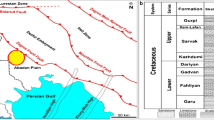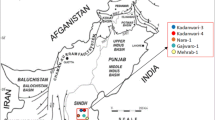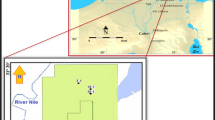Abstract
Southern Iran is one of the most significant parts of the world in terms of economic aggregation of hydrocarbons. In this paper, reservoir quality of the Cenomanian–Santonian deposits has been evaluated in southwestern Iran. According to the reservoir qualification, five particular rock types have been classified based on log responses through K-nearest neighbors (KNN) method. 1–5 are representing poor, weak, moderate, superior and non-reservoir types of rock, respectively. Rock types 3 and 4 are determined as the best types which can play a suitable reservoir role in hydrocarbon accumulation. The mentioned groups generally consist of porous limestones with low level of clay content. Rock types number 1 and 2 indicate the low porosity tight limestones and rock type 5 belongs to clays and shaly layers with high gamma radiations. Lithology of these intervals is specified using Rhomaa–Umaa and NPHI–RHOB crossplots which displayed calcite mineral is the main mineral formed both formations. SEM analysis and Th–K crossplot confirmed that Illite, Montmorillonite and Kaolinite are major clay minerals settled in these intervals that may have impact on reservoir characteristics. Interparticle and micro-porosities are considered as dominant kinds of porosities based on velocity deviation log (VDL) and it is proved by SEM results. Rock types 3 and 4 have been considered as the most productive zones which can be the best target for future perforating operation. According to petrophysical evaluation results, Ilam (Santonian) reservoir quality is enhanced toward northeast and southwest (Maximum abundance of rock type 4) of the studied area in comparison to central part. The Sarvak (Cenomanian–Turonian) Formation is in the highest level of reservoir quality in the southwest of the studied area (abundance of rock types 4 and 3).

modified by Rajabi et al. (2010)













Similar content being viewed by others
References
Abdollahie Fard I, Braathen A, Mokhtari M, Alavi SA (2006) Interaction of the Zagros Fold-Thrust Belt and the Arabian-type, deep-seated folds in the Abadan Plain and the Dezful Embayment, SW Iran. Petrol Geosci 12:347–362
Aghanabati A, (2004) Geology of Iran, Geological survey of Iran, Tehran. Persian Iran J Geol
Amirkhani A, Mirzakhanian M, Sepahvand S et al (2015) Upper cretaceous petroleum system of northwestern persian Gulf. Iran J Earth Sci 7:153–163
Anselmetti FS, Eberli GP (1999) The Velocity-Deviation Log tool to predict pore type and permeability trends in carbonate drill holes from sonic and porosity or density logs. AAPG BulletinV. 83(3):450–466
Assadi A, Honarmand J, Moallemi S et al (2016) Depositional environments and sequence stratigraphy of the Sarvak Formation in an oil field in the Abadan Plain. SW Iran Facies 62:26
Assadi A, Honarmand J, Moallemi SA et al (2018) An integrated approach for identification and characterization of palaeo-exposure surfaces in the upper Sarvak Formation of Abadan Plain, SW Iran. J Afr Earth Sci. https://doi.org/10.1016/j.jafrearsci.2018.05.002
Cluff R, Cluff S, Sharma R, Sutton C (2015) A Deterministic lithology model for the green river-upper wasatch interval of the uinta basin. AAPG Annual Convention & Exhibition, Denver
Duan R, Leyuan F, Guiqin H (2017) Integration study of reservoir rock typing and reservoir prediction in TM oil field. In: International field exploration and development conference, Chengdu, China
Ehrenberg SN, Walderhaug O, Bjørlykke K (2012) Carbonate porosity creation by mesogenetic dissolution reality or illusion? American Association of Petroleum Geologists. Bulletin 96: 217–233.
Elahifard I, Alavi SA, Mokhtari M (2006) Structural framework of the Abadan plain (SW IRAN) and the north Persian gulf based on the geophysical data. J Sci (University of Tehran) (JSUT), Fall 2006, 32(3) (Section geology 2): 107–120
Ellis DV, Singer JM (2008) Well Logging for Earth Scientists, Springer, Chicago
Ghazban F (2009) Petroleum geology of the persian Gulf, vol 2. University of Tehran, Tehran, Iran, pp 231–275
Google earth V 7.3.3.7786. (Sep 19, 2020). Khuzestan, Iran
Hesselbo SP (1996) Spectral Gamma-ray logs in relation to clay mineralogy and sequence stratigraphy, Cenozoic of the Atlantic margin, offshore New jersey, Ocean Drilling Program, Scientific Results, vol. 150
Jiang L, Richard W, Cai C et al (2018) Contrasting diagenetic evolution patterns of platform margin dolostone and limestone in the Lower Triassic Feixianguan Formation, Sichuan Basin. China Marine Pet Geol 92:332–351
Jiang L, Worden RH, Cai CF, Shen A, Crowley SF (2018) Diagenesis of an evaporite-related carbonate reservoir in deeply buried Cambrian strata, Tarim Basin, Northwest China. AAPG Bulletin 102:77–102
Kadkhodaie A, Kadkhodaie R (2018) A review of reservoir rock typing methods in carbonate reservoirs: relation between geological, seismic, and reservoir rock types. Iran J Oil Gas Sci Technol 7(4):13–35
Khormali F, Abtahi A, Owliaie H (2005) Late Mesozoic-Cenozoic clay mineral successions of southern Iran and their palaeoclimatic implications. Clay Miner 40:191–203
Klaja J, Dudek L (2016) Geological interpretation of spectral gamma ray(SGR) logging in selected boreholes. Nafta-gaz, Nr1/2016.
Motiei, H (1993) Stratigraphy of zagros. Treatise on the geology of Iran. Geological survey of Iran, Tehran. (in Persian)
Omidi R, Sadeghi A, Hosseini Barzi MA et al (2018) Summer 2018, vol 12(46), pp 75–92
Pakparvar S, Kohansal N, Jahani D (2017) Sarvak reservoir facies characteristics in one of the South West Field in Iran. Open J Geol 7(3):279–294
Quirein JA, Gardner JS, Watson JT (1982) combined natural gamma ray spectral/litho-density measurements applied to clay mineral identification. AAPG Bull 66(9)
Rajabi M, Sherkati S, Bohloli B et al (2010) Subsurface fracture analysis and determination of in-situ stress direction using FMI logs: an example from the Santonian carbonates (Ilam Formation) in the Abadan Plain. Iran Tectonophys 492:192–200
Saadatfar H, Khosravi S, Joloudari JH, Shamshirband S et al (2020) A new K-nearest neighbors classifier for big data based on efficient data pruning. Mathematics 8:286
Schlumberger (2009) Log interpretation charts. Chart book
Sherkati S, Letouzey J (2004) Variation of structural style and basin evolution in the central Zagros (Izeh zone and Dezful Embayment), Iran Mar. Pet Geol 21:535–554
Tavakoli V (2020) Carbonate Reservoir Heterogenety SpringerBrief in Petroleum Geoscience and Engineering, EBOOK, pp 32–33
Wang X, Yang S, Zhao Y, Ya W (2018) Lithology identification using an optimized KNN clustering method based on entropy-weighed cosine distance in Mesozoic strata of Gaoqing field, Jiyang depression. J Petrol Sci Eng. https://doi.org/10.1016/j.petrol.2018.03.034
Ye SJ, Rabiller P (2000) A new tool for electro-facies analysis: multi-resolution graph-based clustering. In: SPWLA 41th annual logging symposium
Author information
Authors and Affiliations
Corresponding author
Additional information
Publisher's Note
Springer Nature remains neutral with regard to jurisdictional claims in published maps and institutional affiliations.
Rights and permissions
About this article
Cite this article
Kelishami, S.B.A., Mohebian, R. Petrophysical rock typing (PRT) and evaluation of Cenomanian–Santonian lithostratigraphic units in southwest of Iran. Carbonates Evaporites 36, 13 (2021). https://doi.org/10.1007/s13146-020-00669-3
Accepted:
Published:
DOI: https://doi.org/10.1007/s13146-020-00669-3




